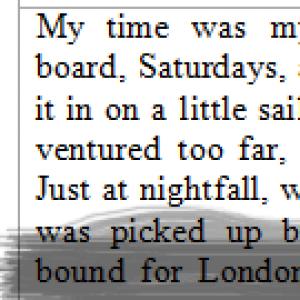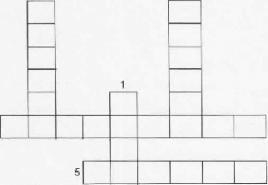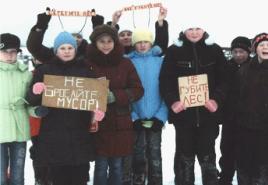Parallel translations for learning English. Bilingual books: what are they and how to read them
- one of the most interesting and accessible methods of learning a foreign language, however, the method of working with parallel texts is not as simple and transparent as it might seem at first glance.
When reading, you need to master a large amount of new information: you will meet new words and new or not quite learned grammatical constructions. This amount of information can either greatly delay reading, or simply slip away without a trace.
Moreover, attempts to read English-language literature in this way sometimes not only do not enrich the knowledge of a foreign language, but also prevent an elementary understanding of the content of the text. It can be very frustrating when working with mixed texts is disappointing or seems useless.
In order for parallel reading to be fruitful, to quickly advance you in the accumulation of knowledge and in improving your skills, you must follow a pre-planned methodology, set realistic goals and develop a strategy that meets these goals. It is quite simple to develop your own method, your own strategy. The next part of the article contains some tips to help you get it done faster.
Why and what to read?
It is very important that the reading of parallel texts is just reading, and not an exercise, that is, the greatest attention should be paid to the content of the text. Language strives to be useful and necessary, and reading is one of the natural uses of your knowledge of the language.
That is why it is absolutely not necessary to read absolutely all the consolidated texts that are available to you: choose the ones that are really interesting to you.
Rudyard Kipling's collection Just So Stories belongs to the so-called cycle of children's why-stories, where the author offers his own versions of certain phenomena, for example, how a leopard became spotted or where a camel got a hump.
One way to learn English is to read. Regular reading in English not only allows you to expand your vocabulary in the most natural, enjoyable and accessible way, but also observe the practical application of grammatical structures in finished texts.
If you regularly read the fiction of English-speaking writers, you will master "correct" English, which is different from spoken English.
In addition, you become familiar with the culture of the countries of the language being studied, have the opportunity to "observe" the natural behavior of the characters in the books in various life situations.
Easy texts in English for beginners can be divided into two types:
- simple literary texts;
- topics - short stories on specific topics.
At first, both children and adults can recommend topics on the simplest topics - about yourself, about your family, about your daily routine, about the weather, about holidays. Children are likely to be interested in stories about toys, about animals.
Topics
Here are examples of some of these light topic texts in English:
my family
Meet my family. There are five of us - my parents, my elder brother, my baby sister and me. First, meet my mum and dad, Jane and Michael. My mum enjoys reading and my dad enjoys playing chess with my brother Ken. My mum is slim and rather tall. She has long red hair and big brown eyes. She has a very pleasant smile and a soft voice. My mother is very kind and understanding. We are real friends. She is a housewife. As she has three children, she is always busy around the house. She takes care of my baby sister Meg, who is only three months old. My sister is very small and funny. She sleeps, eats and sometimes cries. We all help our mother and let her have a rest in the evening. Then she usually reads a book or just watches TV. My father is a doctor. He is tall and handsome. He has short dark hair and gray eyes. He is a very hardworking man. He is rather strict with us, but always fair. My elder brother Ken is thirteen, and he is very clever. He is good at Maths and always helps me with it, because I can hardly understand all these sums and problems. Ken has red hair and brown eyes. My name is Jessica. I am eleven. I have long dark hair and brown eyes. I am not as clever as my brother, though I try to do my best at school too. I am fond of dancing. Our dancing studio won The Best Dancing Studio 2015 competition last month. I am very proud of it. I also like to help my mother with my little sister very much. Our family is very united. We love each other and always try to spend more time together.
My family
Meet my family. There are five of us - my parents, my older brother, my little sister and myself. First, meet my mom and dad, Jane and Michael. My mom loves to read and my dad loves to play chess with my brother Ken. My mother is slim and quite tall. She has long red hair and big brown eyes. She has a very pleasant smile and a gentle voice. My mother is very kind and understanding. We are true friends. She is a housewife. Since she has three children, she is always busy around the house. She takes care of my baby sister Meg, who is only three months old. My sister is very small and funny. She sleeps, eats and sometimes cries. We all help our mother and give her a rest in the evening. Then she usually reads a book or just watches TV. My dad is a doctor. He is tall and handsome. He has short dark hair and gray eyes. He is a very hardworking person. He is quite strict with us, but always fair. My older brother Ken is thirteen and very smart. He is good at math and always helps me with it because I barely understand all these examples and problems. Ken has red hair and brown eyes. My name is Jessica. I am eleven. I have long dark hair and brown eyes. I'm not as smart as my brother, although I try hard at school too. Dancing is my hobby. Our dance studio won the Best Dance Studio 2015 competition last month. I am very proud of this. I also really love helping my mom with my little sister. Our family is very friendly. We love each other and always try to spend more time together.
Lunches for school
Every day in elementary school in America begins at 9.20 a.m. Children have classes till 3.15 p.m. At 12 o'clock children have lunch. Many boys and girls bring their lunch from home. But some of them go for lunch to a school cafeteria.
Mrs. Bradley prepares school lunches almost every weekday for her two children. Sometimes she gives the children money and they eat in the school cafeteria. But usually the children prefer to take a lunch from home.
This morning Bradley is making peanut butter and cheese sandwiches, the children's favorite. She puts two bottles of apple juice for the children to drink. She is going to put the sandwiches, some cherry tomatoes and two bananas in their lunchboxes. The lunchbox is easy for the children to carry to school.
school lunches
Every day in elementary school in America starts at 9:30 in the morning. Lessons for children last until 3.15 days. At 12 o'clock the children have lunch. Many boys and girls bring their lunch with them. But some go to lunch in the school cafeteria.
Mrs. Bradley cooks school lunches for her two children almost every working day. Sometimes she gives the children money and they eat in the school cafeteria. But usually children prefer to take lunch from home.
This morning, Mrs. Bradley makes peanut butter and cheese sandwiches, the favorite (sandwiches) of the children. She puts down two bottles of apple juice for the children to drink. She is going to put sandwiches, some cherry tomatoes and two bananas in their lunch boxes. It's easy for kids to carry a lunchbox to school.
Giraffes
There are different kinds of animals on our planet, and all of them are very important for it. For example, everybody knows that the sharks are dangerous for people, but they are useful for cleaning seawater. There are two types of animals: domestic (or pets) and wild. People keep pets in their homes. And some wild animals are very dangerous. Domestic animals live next to people, whereas wild animals’ “homes” are forests, jungles, oceans and so on.
Giraffes are very beautiful and unusual animals. They are the tallest land animals in the world. Giraffes can reach a height of 5.5 m and a weight of 900 kg. They are famous for their long necks. But does anybody know that giraffes have a very long tongue? They can even clean the ears with it! Giraffes are usually yellow or light brown with dark stains. Giraffes live in African savannas. They can live from 20 to 30 years. It is interesting to know that giraffes sleep only twenty minutes at a time. They sit down on the ground and bend their long neck down.
Giraffes do not hunt. They eat leaves, grass, and fruit. Due to their long neck, they can reach the highest leaves on the trees that other animals cannot eat.
You can often meet giraffes in city Zoos. They are very friendly and all the children like them very much.
giraffes
There are many different types of animals on the planet, and all of them are very important for her. For example, everyone knows that sharks are dangerous to humans, but they are useful for purifying sea water. There are two types of animals - domestic (or pets) and wild. People keep pets in their homes. And some wild animals are very dangerous. Domestic animals live close to people, while the "homes" of wild animals are forests, jungles, oceans, and so on.
Giraffes are very beautiful and unusual animals. They are the tallest land animals in the world. Giraffes can reach a height of 5.5 meters and a weight of 900 kg. They are famous for their long necks. But does anyone know that giraffes have a very long tongue? They can even clean their ears! Giraffes are usually yellow or light brown with dark spots. Giraffes live in the African savannas. They can live from 20 to 30 years. It is interesting to know that giraffes sleep no more than 20 minutes at a time. They sit on the ground and bend their long necks.
Giraffes don't hunt. They eat leaves, grass and fruits. Thanks to their long necks, they can reach the very top leaves on trees that other animals cannot eat.
You can often meet giraffes in city zoos. They are very friendly and the children love them very much.
Fiction for Easy Reading in English
As for literary texts, it is advisable for beginners to choose adapted books. Now you can pick up works of art for any level of language proficiency, with dictionaries, comments and translation. At the initial stage, short and easy texts for reading in English are suitable, as well as specially adapted books of the first three levels of complexity (starter, beginner, elementary). You don't have to look up every unfamiliar word in the dictionary. As you read the story, try to guess the meaning of unfamiliar words. If the book you have chosen corresponds to your level, then there will not be too many such words, and you will be able to understand the meaning of what you read.
Here are some of the works of English and American writers that are easy to find in an adapted version in English. All these books have been translated into Russian and are well known to Russian readers, which, of course, will provide additional assistance when reading them in English.
How to get the best out of reading
So, you have decided to build your English base by reading English books. But finding and reading texts in English for beginners is only half the battle. For a good result, you need not only to read, but also to work with the material read. Here are some tips on how to do it.
- Look for English texts with audio accompaniment. So you can not only increase your vocabulary, but also control and improve your pronunciation.
- Look for English texts with tasks after them. These can be questions, various exercises for choosing words or correct options, etc. This will give you an additional opportunity to fix new words in memory and work out grammatical constructions.
- If there are no exercises after the texts, try the "Why" -questions method. It lies in the fact that, based on what you read, you yourself can make up several questions for yourself, starting with “Why?”. Moreover, it is better if the text does not contain a direct answer to your questions and you have to reason or think something while answering them.
- Try using the text to make a brief retelling, no more than 7-8 sentences. It is advisable to use new words. Learn the retelling by heart. Speak it out loud.
Online text comprehension exercise for beginners
Read the text and do the tasks.
The trip to my Granny
Yesterday I visited my Granny in the countryside. We go there every weekend and I enjoy these trips. But not this time. It was raining cats and dogs, our car broke several times and we were all very tired. But when we saw the Granny, I forgot about the difficulties.
Answer the questions
Indicate whether the statements in the text are true (true - correct, false - incorrect)
Write a sentence that reflects the main idea of this text.
In world the is Family the best thing ... in world the is Family the best thing ... in world the is Family the best thing ... in world the is Family the best thing ... in world the is Family the best thing ... in world the is Family the best thing ... in world the is Family the best thing ... in world the is Family the best thing !
You will find even more simple texts and online exercises in the Lim English online learning service. Sign up and start learning!
Among the ways of learning English, the method of learning English from books with parallel translation is deservedly popular. There are many methods of learning foreign languages. One of the effective methods of learning a foreign language is immersion in the language environment. For various reasons, not every foreign language learner has the opportunity to immerse himself in the language environment. There is nothing wrong with this, since there is an equally effective way to learn English from books with parallel translation. Let's look at the advantages and find out ways to overcome these limitations with the help of the English language tutorial - the VoxBook audio course. The audio course is based on audio books in English, in which the audio material is synchronized with the text of the book, and provided with a parallel translation into Russian.
Parallel translation from English
Parallel text, bitext, bilingual, parallel text or parallel translation from English is a translation and the original text on one sheet. If you take two books, the original and its translation, then this will already be a parallel translation. Usually, both texts are placed on the same sheet or on adjacent sheets of the book, aligning the original text and its translation by paragraphs, sentences, or even words.
Reading parallel texts is the most accessible method of self-study of the English language. It is easy to understand the meaning of the sentences from the parallel text. By memorizing and repeating phrases from the text, you can effectively replenish your vocabulary and get used to the grammar of the language being studied.
Not all parallel translations are suitable as an English language tutorial. Only word-for-word translation with the addition of an explanatory literal translation is suitable for teaching. On the Internet, you can download parallel translations of books based on literary translation. Such bilingual books are suitable only for those who are very advanced in English and are not suitable for beginners to learn the language.
An example from a book with a literary parallel translation from English into Russian: 
By reading books with parallel translation without listening to audio recordings of the text and without adhering to a special teaching method, you will only be able to increase your passive vocabulary. For the development of other skills, such as listening to the English language, increasing active and passive vocabulary, developing the correct pronunciation of words, developing speaking and writing, a special computer program has been developed - the trainer - the VoxBook English audio course and the method of learning the language using it. With the VoxBook audio course based on books with parallel translation, synchronized with an audiobook in English, you will receive highly effective training:
- English listening,
- learn the correct pronunciation of words and intonation of English sentences,
- expand your active and passive vocabulary,
- develop speaking,
- learn to write without mistakes,
- and you will also be able to start studying grammar based on non-adapted English literature.
Parallel translation in the VoxBook English simulator
The VoxBook English simulator uses books in English with parallel translation, which is based on a word-by-word translation to which an explanation can be added. Here is how a parallel translation of one of the Jack and the Beanstalk tales (Jack the beanstalk) from the audio course looks like:
So Jack jumped up and dressed himself and went to the window. And what do you think he saw [and what do you think he saw]? Why, the beans his mother had thrown out of the window into the garden had sprung up into a big beanstalk [some big stalk came up] which went up and up and up [who went up and up and up] till it reached the sky [until he reached the sky]. So the man spoke the truth after all [and so the man spoke the truth "after everything"].(English Fairy Tales - "Jack and the Beanstalk")
Parallel translation is enclosed in square brackets, which may contain words in parentheses. Parentheses highlight a translation of a word that is not in the English text but is necessary for the meaning of the book to be understood. These words can be conjunctions, prepositions, verbs and other parts of speech:
...the beans his mother had thrown out of the window into the garden [beans (which) his mother threw out of the window into the garden]
Quotation marks "..." may appear in parallel translations of the book. They place an incomprehensible word-for-word translation of the text, followed by an understandable literary translation after the = sign.
(From the example above)
So Jack jumped up and dressed himself [so Jack jumped up and "dressed himself" = got dressed]
After a parallel translation of the text of the book from English, there may be grammatical and lexical explanations for the translation, which is highlighted in italics:
The beanstalk grew up quite close past Jack's window [a beanstalk grew very close outside Jack's window: grew up - grew;]
In this case, the phrasal verb grew up is explained. Such clarifications may relate to the lexical and grammatical difficulties of translation. Most often, such explanations relate to phrasal verbs of the English language, which are difficult to look for in Muller's English-Russian dictionary built into the audio course.
The appearance of the program (on the left is the text from the book in English with parallel translation, at the bottom of the audio player control button, on the right are all the texts from the book):

How to read books in English with parallel translation
In the English language tutorial, all texts from the book and their parallel translation are synchronized with the audio recording and divided into paragraphs. First comes a paragraph of the text of the book with a parallel translation, followed by the same text in English without translation. The study of educational material in the audio course goes by paragraphs. The methodology for learning English from books with parallel translation consists of a sequence of steps that are repeated for each new paragraph. Consistently completing them, you will learn English listening comprehension, learn the correct pronunciation of words and intonation in an English sentence, replenish your active and passive vocabulary, develop speaking and learn to write without errors. Let's take a closer look at these steps:

This concludes the study of the passage. You can move on to the next passage, the study of which again begins with the first step and ends with the seventh step, and so on, passage by passage, until the end of the text. At the end of the text, try to retell the entire text from memory. Such a retelling will further develop your speaking skills and consolidate your active vocabulary.
Bram Stoker - Bram Stoker
R. L. Stevenson - Wikiwand R. L. Stevenson
Washington Irving - Wikiwand Washington Irving
Fairy tales
If you are interested in this section of the site, then you have already made significant progress in learning English and are ready for an almost complete mastering of English texts in the original. "Almost" - because you will refer to the Russian translation as needed. The main goal of this technique is to read and understand the English text, as well as actively replenish vocabulary. You need to refer to the translation "as needed", trying as little as possible focus on Russian text. Remember that there is a danger of reducing the learning process to reading the Russian text, looking through the English text "in passing". The benefits of such reading are minimal.
The more you want to master reading English texts, the greater the effect of learning will be. At the same time, it is important that the content of the text you read be as interesting as possible to you, that is, that you focus as much as possible on the meaning of what you are reading. If you focus specifically on the content of the text, you will better perceive new words and grammatical structures and more naturally choose words to remember. Therefore, fascinating detective stories are offered as texts, because almost everyone is interested in reading them.
For successful reading, it is important to understand that your main task is to independently read the text in English and understand it. Translation is needed in order to clarify the nuances, to check whether you understood the passage correctly, to translate unfamiliar words.
Choose to read a piece of text of the length that you would be comfortable reading, perhaps first it will be one sentence, then two, then a paragraph, etc. Try to read it yourself first, then seek help from the Russian translation, clarifying unclear points, and then re-read this fragment again, consolidating the "grains of knowledge" received. Be patient, stock up on diligence and gradually a huge castle will grow from small grains.
Having trained to read parallel texts, proceed to reading texts with the possibility of "peeping" into the translation, and then to full reading of English texts without peeping. (All of these materials will be gradually uploaded to the site.)
Your application is accepted
Our manager will contact you soon
close
An error occurred while sending
Send again
If you decide to learn a foreign language, then you cannot do without. In our article, we will tell you in detail about bilingual books that will become your indispensable helpers in this difficult task.
You can never understand one language until you understand at least two.
You will never understand one language until you understand at least two
~ Geoffrey Willans
When learning a language, we can use a lot of helpers: movies, audio podcasts, books, websites. Everything is more or less clear - we can turn on subtitles and focus on them. There is a translation for audio. And what to do with the books of your favorite authors, if the vocabulary is small, but you want to read in English? There is a way out - these are bilingual books.
What are bilingual books?
Bilingual books are books in two languages with parallel translation
Bilingual is a bilingual text written in the original language and the target language. There are several types of bilinguals: with literal translation and translation in parts.
Literal translation Suitable for those who have just started learning English. This way of reading helps to learn set expressions, individual words and promotes passive language learning. In books of this type, the text is divided into parts: part 1 - a fragment of the text with a literal translation and lexical and grammatical comments; Part 2 - an excerpt of the text in English.
Translation of the text in parts suitable for those who already know the basic level of the language. In such books, the first part is a fragment of the text, the second part is its translation without any comments. In this way, unfamiliar words can be learned.
Benefits of Bilingual Books
 With the help of bilingual books, you will not only memorize more new words, but you will also be able to “switch” between languages faster
With the help of bilingual books, you will not only memorize more new words, but you will also be able to “switch” between languages faster
Thanks to such books, you will be able to discover books that you may not have dared to read before. The accompanying text will inspire you not only with greater confidence, but will also improve your knowledge of the language being studied. Other benefits of bilingual books include:
Dynamic and enjoyable experience
Let's be honest, how many times would it take you to look into a dictionary while reading a book in English, let's say Oscar Wilde? Bilingual books offer the target language and you don't get stressed out by encountering unfamiliar words;
Deep understanding of sentence structures
A great translation can sometimes contain more meaning and understanding than a typical grammar and vocabulary lesson. Reading bilingual texts forces you to read “native speaker” by helping you understand the differences in sentence structures and texts in each language;
Extensive cultural overview
When you include great books in your reading, you absorb elements of cultural enrichment and the meaning of what is written takes on new colors. Reading in the original language is necessary for an educated person, especially if your level is above the basic one.
On a note:
Start with a book you love. A great start for a bilingual reader is a book they are very familiar with. The English text will look less intimidating and the content will be easier to understand.
Be the hero of this book. Having passed the story through yourself, you will not only remember new words and expressions better, but will make reading more fun and exciting.
Get a notebook of "successful" expressions. By writing down new expressions, idioms and phraseological units, you can easily replenish your vocabulary. In addition, you can use your records at any time when you need them. You can even categorize them for your convenience, such as words/phrases for expressing opinions and feelings, for agreeing and objecting, for describing people and places, useful phrases for paraphrasing and oral presentations. Most importantly, create categories that are logical and convenient for you, and not the way they would be organized in textbooks.
Do exercises. Most bilingual books have vocabulary and comprehension exercises. Don't ignore these quests. They will help you understand the text, moreover, it is a good memory training.
Use the text-to-speech technique. It will help you remember how new words are pronounced. You can also use audiobooks for this, which offer a more natural and lively sound than just listening to single words.
Use new words and grammar soon after reading. Bring new words and phrases to automatism, come up with your own sentences with them. All of them will be better absorbed only when you make them your own.
Find friends by interests. Meet people who are also learning English. Learning a foreign language means communicating with people. Books are one of the most popular topics of conversation. Discuss, share your impressions, read your favorite quotes, you can even role-play - all this will only improve your reading comprehension, and you will immerse yourself more in the language environment.
Compare and analyze long and complex sentence structures. Yes, it will take quite a lot of time, but it will make it easier for you to understand in the future. When you find a similar structure or grammatical element in later reading, you won't spend much time figuring it out because you're already familiar with it. By understanding complex things, you open the way to deeper knowledge.
Websites where you can download bilingual books.
Listening to what is written will only improve your reading comprehension.







